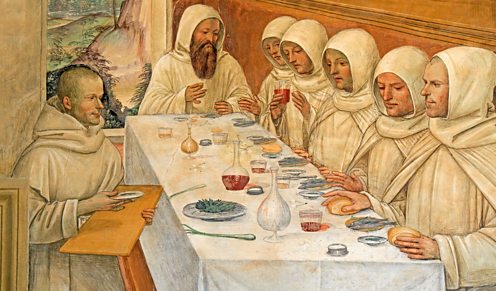
The word monk or from the Greek (monos) is speaking of a man alone that resided in a cave among the mountains or around the woven branches of a tree where the earliest anchorites created their homes.[1] As a way to survive the monks would nourish themselves on berries, the nuts, or dates since it was in the East that monastic life started flourishing.[2] By the exercise of asceticism, they dominated their inner man subduing their passion to obtain the glories of heaven.[3] It was the salvation of their own souls the main concern from where they started working. This lifestyle influenced people and soon both man and woman follow their own example. The rules as communities were created followed and soon the first of the rules known was the one of St. Basil of Pontus.[4] This rule was used throughout the Byzantine Empire up to the late eight and ninth century. By the early times of the fifth century, monasteries were created in the West and by the application of drawing the example of the East famous monasteries were built. such as the one of St. Cassian at Marseille, St. Honorat in Ile de Lerins these two in France.[5] Attaining purity of heart was one of the primary goals. The way to achieve it was through the exercise of fasting, vigils, the toils, bodily nakedness, reading, and other virtues to accomplish it. Exactly by 530, Caesarius of Arles organized a monastery with rules at the same times other monasteries were built in Ireland. Thye gained fame so much that scholar started visiting these places. By the 700 culture and learning had struggled to survived while monasteries maintained balance. Thus this was the reason why scholars flew to them. Yet the barbarians destroyed this peaceful life because even in 795 the Norse ravaged them.[6] Nevertheless, Ireland's loss was Europe's gain, since it was through Ireland that the medieval civilization started to build up.[7] At the same time St. Benedict who was drawn to have a community rather than living in hermits had his Rule created by different influences such as the one of the Desert Fathers, St. Augustine and an unknown monk who created the Rule of the Master. By Benedict's Rule, the Latin monastic life is based during the Middle Ages.[8] In his vision St. Benedict he had at its core the Abbot who was chosen to be the Father figure of the community and to be loved rather than to be feared.[9] Ultimately implicit obedience was given to the Abbot and he had the final decision.

Furthermore along the years in 1058 possession of property led monks to the secular business at the same time brought a mass of people who had no such sense of vocation. As a result, people began to protest against it and movement were created. This such effect led to the creation as well of heretical movements. Such was the case of Peter Waldo who created the Waldenses who went about denouncing this and preaching the Gospel and translating the New Testament into the languages of the people who ended converting. There was another movement such as the one of the Albigensians who taught that Christian faith was a fraud and instead of worshipping Jehovah which they called him instead they worshipped the devil.[10] Pope Innocent III declared war against them and created a Crusade. The friars arrived with a different image seeing the world as their parish, unlike the monks. Their primary goal was to preach Christ's Gospel of Love and Holy Poverty along with Peace. One of the key players of this new rising movement was St. Francis of Assisi who was a very attractive figure. He had in his intention similar approach as the Waldenses that is why Pope Honorius III hesitated to say yes.[11]
Another element to this story of Friars was St. Dominic, who began as a preacher with the Albigensians. He was determined to fight the heretics. He was approved in 1214 and by 1221 the order had gathered 60 friaries on western Europe. The Dominic followers were well educated since Dominic saw that it was through intellectual training and reading to refute heretical thoughts. Nevertheless, there was a rigid outcome when the Dominicans were commissioned to follow the papal inquisition because now the Franciscans were the object of persecution created by the temptation Francis warned.[12] The persecution stopped in 1317 by Pope John XXII who declared that friars was a heretic if he disobeyed his Superior. one of the last great friars was St. Bernardino who practiced the lifestyle of Francis. After his death, Erupoe changed its ways to modernism. Nevertheless, the Middle Ages gave way to intellectual achievements, scientists, the voyages and the art of what is the modern age.[13]
[1] Marjorie Rowling, Life in Medieval Times, Chapter Six: Monks and Friars, (Perigee History, Berkley Publishing Group, New York, 1968), 113.
[2] Marjorie Rowling, Life in Medieval Times, 113.
[3] Marjorie Rowling, Life in Medieval Times, 113.
[4] Marjorie Rowling, Life in Medieval Times, 113.
[5] Marjorie Rowling, Life in Medieval Times, 113.
[6]Marjorie Rowling, Life in Medieval Times, 113-114.
[6]Marjorie Rowling, Life in Medieval Times, 113-114.
[7] Marjorie Rowling, Life in Medieval Times, 117.
[8] Marjorie Rowling, Life in Medieval Times, 118.
[9] Marjorie Rowling, Life in Medieval Times, 118-119.
[10] Marjorie Rowling, Life in Medieval Times, 130.
[11] Marjorie Rowling, Life in Medieval Times, 130-131.
[12] Marjorie Rowling, Life in Medieval Times, 132.
[13]Marjorie Rowling, Life in Medieval Times, 134.
[13]Marjorie Rowling, Life in Medieval Times, 134.
No comments:
Post a Comment